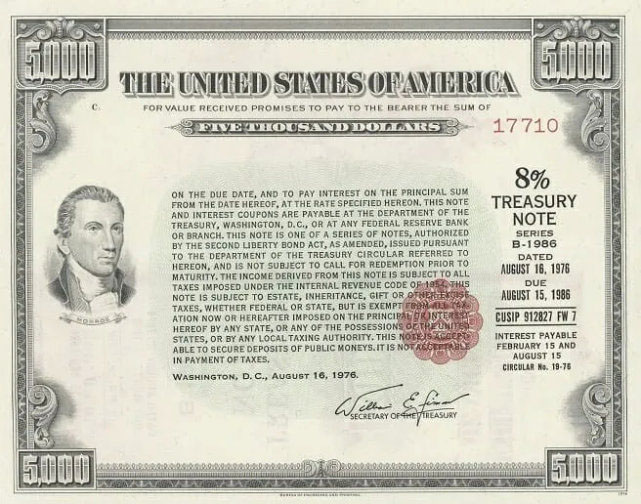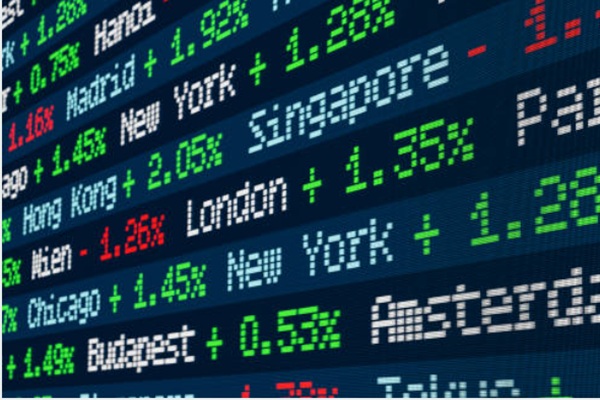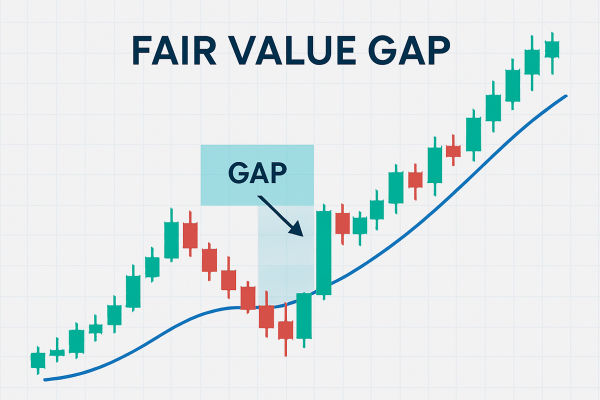The volatility of the stock market and the rise and fall of interest rates
seem to be closely related to the same key factor, which is the 10-year US
Treasury yield. Why does the change in this indicator cause market anxiety so
much? What is the relationship between the 10-year US Treasury yield and
financial market volatility?
A Treasury bond, as its name implies, is a loan from a country that borrows
money from the public and promises to pay interest within a certain period of
time and repay the principal at maturity. US bonds are bonds issued by the US
government. When you lend funds to the US government, you actually receive an
IOU.

This is a Treasury bond issued by the United States in 1976. It can be seen
that the face value of this Treasury bond is $5000. It records important terms
such as the starting date of the loan, the loan term, the loan maturity date,
and the loan interest rate. This promissory note is endorsed by the US
government, and as the US dollar is the world's common currency and the US
government has a high reputation, it is considered a risk-free asset.
So what is the magic of 10-year US Treasury yields?
US bonds have different borrowing terms at the time of issuance, ranging from
one month to 30 years. Short-term US Treasury bonds are susceptible to policy
and market influences, with frequent fluctuations, while long-term US Treasury
bonds have high levels of uncertainty and low liquidity. The ten-year US bonds
have high liquidity, so their yield is widely considered a risk-free yield; that
is, the circulating interest rate of any fund is based on the yield of the
Treasury bond, and the yield of investing in other assets should be at least
higher than this level; otherwise, investors can directly choose to buy US
bonds.
The yield on 10-year US Treasury bonds is also the basis for bank credit loan
rates, including mortgage loans. But some people may wonder, Why does not
everyone buy US bonds when their yields are so high? To understand this issue,
it is first necessary to distinguish between coupon rates and yield to
maturity.
For example, if the coupon rate of a US bond is 2%, it means that the buyer
can receive a 2% return upon maturity. If someone purchases $100 in US bonds,
they will receive an interest rate of $2 after one year. The interest rate of US
bonds is already fixed at the time of purchase, written into contracts and IOUs,
and will not change with future changes. But what we see as US bond yields is
constantly changing because US bonds are traded in the secondary market.
Assuming someone urgently needs money six months after purchasing US bonds,
they will sell their holdings of US bonds to others in the secondary market for
$98. The buyer received the principal and interest after six months, totaling
$102. So, the buyer earns a profit of $4, resulting in a yield to maturity of
4.08% for US bonds. This indicates that the yield of US bonds varies with
changes in US bond prices. The higher the price, the lower the yield, and the
lower the price, the higher the yield.
The current 10-year US Treasury yield is calculated based on the current
transaction price. For example, if the price of a 10-year US bond is $88.2969,
the face value is $100, and the coupon rate is 2.75%, the buyer will receive
interest income of $1.375 after holding it for one year. If redeemed at face
value, the annual yield will be 4.219%. The yield of US Treasury bonds is
inversely proportional to their price, and when investors buy US Treasury bonds
in droves, they push up their prices, resulting in a decrease in US bond yields.
On the contrary, if people are optimistic about US bonds and sell more than they
buy, the price of US bonds will decrease and the yield will increase. The
significant increase in US bond yields is mainly due to the Federal Reserve's
interest rate hike, which has led to investors selling US bonds.
Knowing what 10-year US bonds are, let's discuss the relationship between
10-year US bond yields and financial market volatility.
-
The reverse relationship between interest rates and bond prices
When the yield of 10-year US Treasury bonds increases, bond prices decrease
because newly issued bonds may offer higher interest rates. This has led to
increased volatility in the bond market, as investors holding existing bonds may
see a decrease in their bond market value.
-
Expected inflation rate
The yield of 10-year US Treasury bonds is usually influenced by the expected
inflation rate. If the market expects inflation to rise, investors may demand
higher interest rates to offset the impact of inflation, thereby pushing up bond
yields. This may lead to fluctuations in the financial market, especially on the
stock market, as high inflation rates may weaken purchasing power and have a
negative impact on corporate profits.
-
Hedge demand
Ten-year US Treasury bonds are usually considered a safe haven asset, and
when financial markets experience instability or increased risk sentiment,
investors may transfer funds to the bond market, leading to an increase in bond
prices and a decrease in yields. In this case, the performance of the bond
market may deviate from that of the stock market, which is also one of the
relationships between the 10-year US Treasury yield and financial market
volatility.
-
central bank Policies
The central bank's monetary policy will also affect the yield of 10-year US
Treasury bonds. If the central bank raises interest rates, bond yields may rise
because the market expects interest rates to rise. This may trigger fluctuations
in the financial market, especially in the stock and real estate markets, as
high interest rates may suppress borrowing and investment activities.
-
International factors
Events in the global economy and financial markets can also affect 10-year US
Treasury yields and financial market volatility. For example, international
trade tensions, geopolitical events, or global economic downturns may lead
investors to seek safety, thereby affecting the US bond market and other asset
markets.
What is the relationship between interest rate hikes and rising US bond
yields?
Raising interest rates means raising the benchmark interest rate, which will
also increase the interest rates of various financial assets in the United
States, such as bank deposits. For investors, if the deposit interest rate was
1.5% in the past year, they can now earn 3% interest. However, the interest rate
on US Treasury bonds is fixed, assuming a one-year rate of 2%, which is lower
than the deposit rate after interest rate hikes. In order to obtain higher
returns, investors often sell US bonds and deposit their funds in banks,
resulting in more people selling US bonds than buying them in the market,
leading to a decrease in US bond prices and an increase in yields. That's why,
as the Federal Reserve begins to raise interest rates, US bond yields continue
to rise.
Disclaimer: This material is for general information purposes only and is not intended as (and should not be considered to be) financial, investment or other advice on which reliance should be placed. No opinion given in the material constitutes a recommendation by EBC or the author that any particular investment, security, transaction or investment strategy is suitable for any specific person.







